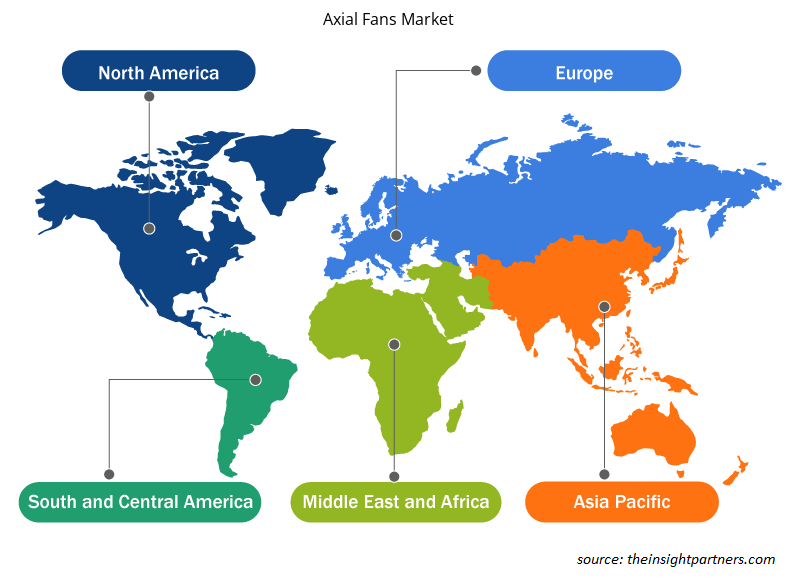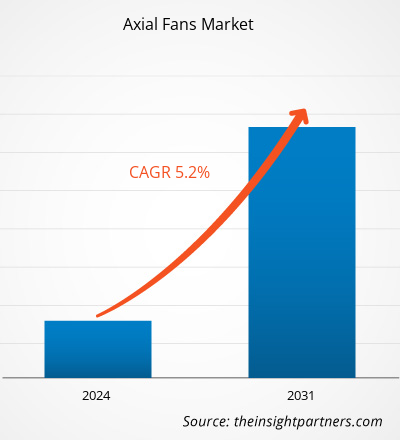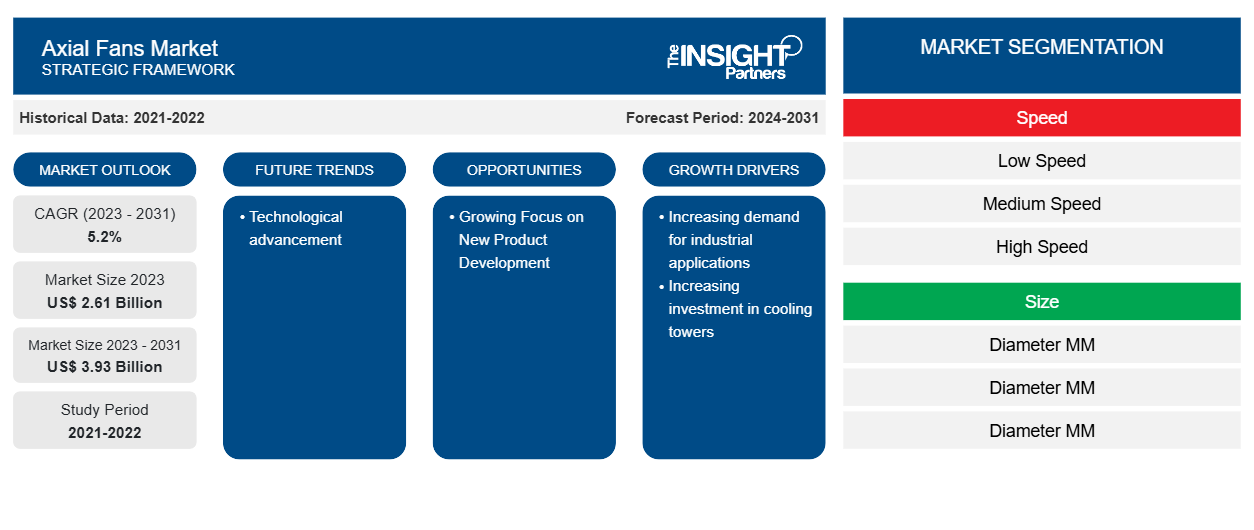Si prevede che il mercato dei ventilatori assiali crescerà da 2,61 miliardi di dollari nel 2023 a 3,93 miliardi di dollari entro il 2031; si prevede che si espanderà a un CAGR del 5,2% dal 2023 al 2031. Si prevede che il progresso tecnologico sarà una tendenza chiave nel mercato.CAGR of 5.2% from 2023 to 2031. Technological advancement is anticipated to be a key trend in the market.
Analisi di mercato dei ventilatori assiali
I ventilatori assiali sono ideali per sistemi di riscaldamento, ventilazione e aria condizionata. Diverse proprietà definiscono i ventilatori assiali. Esempi di queste qualità sono un diametro ampio , una larghezza radiale stretta e un design a basso profilo. Queste caratteristiche specifiche contribuiscono alle elevate prestazioni dei ventilatori a flusso assiale. I ventilatori a flusso assiale sono anche ampiamente utilizzati nel settore. I ventilatori assiali possono estrarre aria dai filtri rotanti e dalle trincee di ritorno dell'aria. Possono anche essere utilizzati come scarico. Grazie a tutti questi vantaggi, si prevede che la domanda di ventilatori assiali crescerà durante il periodo di previsione.
Panoramica del mercato dei ventilatori assiali
Un ventilatore assiale è un ventilatore che consente al gas di fluire attraverso di esso in direzione assiale, parallelamente all'albero attorno al quale si muovono le pale. Il flusso è assiale all'ingresso e all'uscita. Il ventilatore è progettato per produrre una differenza di pressione, e quindi una forza, che provoca un flusso attraverso il ventilatore. I ventilatori assiali sono ideali per generare un flusso d'aria ad alto volume in sistemi a bassa pressione. I ventilatori assiali sono disponibili in diverse dimensioni e possono essere inseriti in una grande piastra di montaggio o in un piccolo raggio. I raggi corti sono i più predominanti e determinano un flusso laminare, mentre i metodi verticali, di montaggio a parete, di montaggio sul tetto e altri metodi forniscono un flusso laminare regolare.
Personalizza questo report in base alle tue esigenze
Riceverai la personalizzazione gratuita di qualsiasi report, comprese parti di questo report, o analisi a livello nazionale, pacchetto dati Excel, oltre a usufruire di grandi offerte e sconti per start-up e università
-
Scopri le principali tendenze di mercato in questo rapporto.Questo campione GRATUITO includerà analisi di dati che spaziano dalle tendenze di mercato alle stime e alle previsioni.
Driver di mercato e opportunità per i ventilatori assiali
La crescente domanda di applicazioni industriali favorisce la crescita del mercato.
I ventilatori assiali industriali sono dispositivi meccanici che trasportano aria o altri gas in diverse applicazioni industriali. Funzionano facendo girare un rotore centrale o una girante ad alta velocità, con conseguente flusso di aria o gas diretto attraverso una serie di palette o pale. Questo flusso può essere utilizzato per ventilare, raffreddare o far circolare l'aria in una varietà di ambienti industriali, a seconda delle esigenze specifiche dell'applicazione. I ventilatori assiali sono popolari in una varietà di applicazioni. Sono estremamente efficienti e risparmiano energia. Inoltre, sono meno rumorosi dei ventilatori centrifughi. Le pale dei ventilatori assiali possono essere spazzate o inclinate. I ventilatori assiali possono essere personalizzati per soddisfare una gamma di esigenze. Pertanto, si prevede che la domanda di ventilatori assiali per applicazioni industriali crescerà durante il periodo di previsione.
Crescente attenzione allo sviluppo di nuovi prodotti
I principali partecipanti al mercato si stanno concentrando sullo sviluppo di nuovi prodotti e sul progresso tecnologico. Si prevede che ciò creerà prospettive di crescita redditizie per la crescita del mercato dei ventilatori assiali durante il periodo di previsione. Ad esempio, a settembre 2023, Mainstream, un noto produttore di ventilatori e serpentine per unità di trattamento aria, ha annunciato il lancio dei suoi nuovi ventilatori assiali IntelliCUBE. Mainstream sta rafforzando la sua posizione di leader del settore HVAC, portando avanti la tradizione di un'azienda familiare da tre generazioni. Inoltre, a settembre 2022, ebm-papst ha lanciato un nuovo ventilatore assiale per applicazioni ferroviarie con elevata contropressione.IntelliCUBE Axial Fans. Mainstream is strengthening its position as an HVAC industry leader, carrying on the tradition of a three-generation family business. Further, in September 2022, ebm-papst launched a novel axial fan for railway applications with high back pressure.
Analisi della segmentazione del rapporto di mercato dei ventilatori assiali
I segmenti chiave che hanno contribuito alla derivazione dell'analisi di mercato dei ventilatori assiali sono velocità, dimensioni, applicazione, tipo e utente finale.
- In base alla velocità, il mercato è suddiviso in bassa velocità, media velocità e alta velocità.
- In base alle dimensioni, il mercato è suddiviso in Diametro (130-250) MM, Diametro (250-910) MM, Diametro (910-1500) MM e Diametro superiore a 1500 MM.
- in base all'applicazione, il mercato è segmentato in radiatori, raffreddamento e refrigerazione, ventilazione e altri.
- In base alla tipologia, il mercato è segmentato in AC, DC ed EC.
- in base agli utenti finali, il mercato si divide in commerciale, industriale e residenziale.
Analisi della quota di mercato dei ventilatori assiali per area geografica
In base alla regione, il mercato è segmentato in Nord America, Europa, Asia Pacifico, Medio Oriente e Africa, Sud e Centro America.
Si prevede che l'Asia Pacifica detenga una quota importante del mercato dei ventilatori assiali per tutto il periodo di previsione. Questa crescita può essere attribuita alla crescente domanda da parte di applicazioni industriali e commerciali. Si prevede che anche il Nord America detenga una quota significativa del mercato nel 2023. Si prevede che il rapido ritmo degli sviluppi tecnologici e delle normative governative di supporto stimoli la domanda di ventilatori assiali dalla regione nordamericana durante il periodo di previsione.
Approfondimenti regionali sul mercato dei ventilatori assiali
Le tendenze regionali e i fattori che influenzano il mercato dei ventilatori assiali durante il periodo di previsione sono stati ampiamente spiegati dagli analisti di Insight Partners. Questa sezione discute anche i segmenti e la geografia del mercato dei ventilatori assiali in Nord America, Europa, Asia Pacifico, Medio Oriente e Africa e Sud e Centro America.

- Ottieni i dati specifici regionali per il mercato dei ventilatori assiali
Ambito del rapporto di mercato sui ventilatori assiali
| Attributo del report | Dettagli |
|---|---|
| Dimensioni del mercato nel 2023 | 2,61 miliardi di dollari USA |
| Dimensioni del mercato entro il 2031 | 3,93 miliardi di dollari USA |
| CAGR globale (2023-2031) | 5,2% |
| Dati storici | 2021-2022 |
| Periodo di previsione | 2024-2031 |
| Segmenti coperti |
Per velocità
|
| Regioni e Paesi coperti |
America del Nord
|
| Leader di mercato e profili aziendali chiave |
|
Densità dei player del mercato dei ventilatori assiali: comprendere il suo impatto sulle dinamiche aziendali
Il mercato dei ventilatori assiali sta crescendo rapidamente, spinto dalla crescente domanda degli utenti finali dovuta a fattori quali l'evoluzione delle preferenze dei consumatori, i progressi tecnologici e una maggiore consapevolezza dei vantaggi del prodotto. Con l'aumento della domanda, le aziende stanno ampliando le loro offerte, innovando per soddisfare le esigenze dei consumatori e capitalizzando sulle tendenze emergenti, il che alimenta ulteriormente la crescita del mercato.
La densità degli operatori di mercato si riferisce alla distribuzione di aziende o società che operano in un particolare mercato o settore. Indica quanti concorrenti (operatori di mercato) sono presenti in un dato spazio di mercato in relazione alle sue dimensioni o al valore di mercato totale.
Le principali aziende che operano nel mercato dei ventilatori assiali sono:
- Rosenberg Ventilatoren GmbH
- Tifosi Sofasco
- Azienda leader nella produzione di macchinari elettrici.
- Ziehl Abegg
- Società Omron
- Idrija
Disclaimer : le aziende elencate sopra non sono classificate secondo un ordine particolare.

- Ottieni una panoramica dei principali attori del mercato dei ventilatori assiali
Notizie di mercato e sviluppi recenti sui ventilatori assiali
Il mercato dei ventilatori assiali viene valutato raccogliendo dati qualitativi e quantitativi dopo la ricerca primaria e secondaria, che include importanti pubblicazioni aziendali , dati associativi e database. Di seguito sono elencati alcuni degli sviluppi nei ventilatori assiali:
- Aerosystems, un marchio leader nella progettazione e produzione di sistemi di ventilazione, ha ampliato le scelte dimensionali della sua popolare serie di ventole assiali. La nuova ventola assiale numero di parte 7010000 è un dispositivo di raffreddamento e ventilazione originariamente sviluppato per l'applicazione di Aircraft ECS. (Fonte: Aerosystems, comunicato stampa, dicembre 2021)
Copertura e risultati del rapporto di mercato sui ventilatori assiali
Le previsioni di mercato dei ventilatori assiali sono stimate in base a vari risultati di ricerche secondarie e primarie, come pubblicazioni aziendali chiave, dati di associazioni e database. Il rapporto di mercato "Dimensioni e previsioni del mercato dei ventilatori assiali (2021-2031)" fornisce un'analisi dettagliata del mercato che copre le seguenti aree:
- Dimensioni e previsioni del mercato dei ventilatori assiali a livello globale, regionale e nazionale per tutti i principali segmenti di mercato coperti dall'ambito
- Tendenze del mercato dei ventilatori assiali, nonché dinamiche di mercato quali driver, vincoli e opportunità chiave
- Analisi dettagliata delle cinque forze PEST/Porter e SWOT
- Analisi di mercato dei ventilatori assiali che copre le principali tendenze del mercato, il quadro globale e regionale, i principali attori, le normative e i recenti sviluppi del mercato
- Analisi del panorama industriale e della concorrenza che copre la concentrazione del mercato, l'analisi della mappa di calore, i principali attori e gli sviluppi recenti nel mercato dei ventilatori assiali
- Profili aziendali dettagliati.
- Analisi storica (2 anni), anno base, previsione (7 anni) con CAGR
- Analisi PEST e SWOT
- Valore/volume delle dimensioni del mercato - Globale, Regionale, Nazionale
- Industria e panorama competitivo
- Set di dati Excel
Report recenti
Testimonianze
Motivo dell'acquisto
- Processo decisionale informato
- Comprensione delle dinamiche di mercato
- Analisi competitiva
- Analisi dei clienti
- Previsioni di mercato
- Mitigazione del rischio
- Pianificazione strategica
- Giustificazione degli investimenti
- Identificazione dei mercati emergenti
- Miglioramento delle strategie di marketing
- Aumento dell'efficienza operativa
- Allineamento alle tendenze normative























 Ottieni un campione gratuito per - Mercato dei ventilatori assiali
Ottieni un campione gratuito per - Mercato dei ventilatori assiali